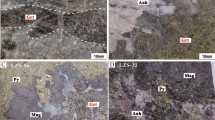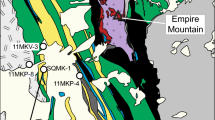Abstract
Proximal and distal garnets from skarns at Jiaduobule, Tibet, are used to demonstrate how variation in the fluid composition and parameters such as salinity, pH, fO2, and \({\text{X}}_{{\rm CO}_{2}}\) will impact on rare earth element (REE) distribution in garnets, and also to constrain skarn evolution across the orefield from proximal (Fe mineralization) to distal (Cu mineralization). These garnets display a diversity from proximal to distal skarn which is expressed in mineral assemblages, textures, major to trace element contents, and particularly, chondrite-normalized REE fractionation trends. The empirical variation among REE fractionation trends, determined from laser ablation inductively coupled-plasma mass spectrometry data, can be numerically modelled in terms of variable fluid compositions and physicochemical parameters, among which the key determining factors are salinity, pH, \({\text{X}}_{{{\text{CO}}_{{2}} }}\) and Ca content buffered from the rock-fluid reaction with carbonate rocks. Modelling REE trends in skarn garnet is shown to be valuable for constraining conditions during garnet formation and a useful tool for monitoring the evolution of complex skarn deposits.










Similar content being viewed by others
References
Banks DA, Yardley BWD, Campbell AR, Jarvis KE (1994) REE composition of an aqueous magmatic fluid: a fluid inclusion study from the Capitan Pluton, New Mexico, USA. Chem Geol 113:259–272
Brugger J, Etschmann B, Pownceby M, Liu W, Grundler P, Brewe D (2008) Oxidation state of europium in scheelite: tracking fluid–rock interaction in gold deposits. Chem Geol 257:26–33
Brugger J, Lahaye Y, Costa S, Lambert D, Bateman R (2000) Inhomogeneous distribution of REE in scheelite and dynamics of Archaean hydrothermal systems (Mt. Charlotte and Drysdale gold deposits, Western Australia). Contrib Mineral Petrol 139:251–264
Carlson WD, Gale JD, Wright K (2014) Incorporation of Y and REEs in aluminosilicate garnet: energetics from atomistic simulation. Am Mineral 99:1022–1034
Ciobanu CL, Cook NJ, Ehrig K (2017) Ore minerals down to the nanoscale: Cu-(Fe)-sulphides from the iron oxide copper gold deposit at Olympic Dam, South Australia. Ore Geol Rev 81:1218–1235
Ciobanu CL, Cook NJ, Utsunomiya S, Pring A, Green L (2011) Focussed ion beam-transmission electron microscopy applications in ore mineralogy: bridging micron- and nanoscale observations. Ore Geol Rev 42:6–31
Cook N, Ciobanu CL, George L, Zhu Z-Y, Wade B, Ehrig K (2016) Trace element analysis of minerals in magmatic-hydrothermal ores by laser ablation inductively-coupled plasma mass spectrometry: approaches and opportunities. Minerals 6:111
Gaspar M, Knaack C, Meinert LD, Moretti R (2008) REE in skarn systems: a LA-ICP-MS study of garnets from the Crown Jewel gold deposit. Geochim Cosmochim Acta 72:185–205
Guynn JH, Kapp P, Pullen A, Gehrels G, Heizler M, Ding L (2006) Tibetan basement rocks near Amdo reveal “missing” Mesozoic tectonism along the Bangong suture, central Tibet. Geology 34:505–508
Ismail R, Ciobanu CL, Cook NJ, Schmidt Mumm A, Wade B, Giles D, Teale GS (2014) Rare Earths and other trace elements in minerals from skarn assemblages, Hillside iron oxide-copper-gold deposit, Yorke Peninsula, South Australia. Lithos 184–187:456–477
Kessel R, Schmidt MW, Ulmer P, Pettke T (2005) Trace element signature of subduction-zone fluids, melts and supercritical liquids at 120–180 km depth. Nature 437:724–727
Krneta S, Ciobanu C, Cook N, Ehrig K (2018) Numerical Modeling of REE Fractionation patterns in fluorapatite from the olympic dam deposit (South Australia). Minerals 8:342
McDonough WF, Sun SS (1995) The composition of the Earth. Chem Geol 120:223–253
McIntire WL (1963) Trace element partition coefficients—a review of theory and applications to geology. Geochim Cosmochim Acta 27:1209–1264
Meinert LD, Dipple GM, Nicolescu S (2005) World skarn deposits. Economic Geology 100th Anniversary Volume, Society of Economic Geologists, littletin, CO, USA, pp 299–336
Migdisov A, Williams-Jones AE, Brugger J, Caporuscio FA (2016) Hydrothermal transport, deposition, and fractionation of the REE: experimental data and thermodynamic calculations. Chem Geol 439:13–42
Pan G-T, Ding J, Yao D-S, Wang L-Q (2004) Guidebook of 1: 1,500,000 geologic map of the Qinghai-Xizang (Tibet) plateau and adjacent areas. Cartographic Publishing House, Chengdu, pp 1–148 (in Chinese)
Park C, Choi W, Kim H, Park MH, Kang IM, Lee HS, Song Y (2017) Oscillatory zoning in skarn garnet: implications for tungsten ore exploration. Ore Geol Rev 89:1006–1018
Smith MP, Henderson P, Jeffries TER, Long J, Williams CT (2004) The rare earth elements and uranium in garnets from the Beinn an Dubhaich Aureole, Skye, Scotland, UK: constraints on processes in a dynamic hydrothermal system. J Petrol 45:457–484
Stalder R, Foley SF, Brey GP, Horn I (1998) Mineral-aqueous fluid partitioning of trace elements at 900–1200 °C and 3.0–5.7 GPa: new experimental data for garnet, clinopyroxene, and rutile, and implications for mantle metasomatism. Geochim Cosmochim Acta 62:1781–1801
Xu J (2017) Metallogenic mechanism and model of the paleogene Fe–Cu–Pb–Zn skarn deposits in Nyainqentanglha, Tibet. Ph.D. thesis: China University of Geosciences, Wuhan (in Chinese with English abstract)
Xu J, Ciobanu CL, Cook NJ, Zheng Y-Y, Sun X, Wade BP (2016) Skarn formation and trace elements in garnet and associated minerals from Zhibula copper deposit, Gangdese Belt, southern Tibet. Lithos 262:213–231
Yu Y-S, Gao Y, Yang Z-S, Hou Z-Q, Tian S-H, Meng X-L, Liu H-F, Zhang J-S, Wang H-P, Liu Y-C (2011) Age and petrogenesis of magmatic rocks from Jiaduobule skarn Fe–Cu deposit in Tibet: evidence from zircon SHRIMP U–Pb dating, Hf isotope and REE. Miner Depos 30:420–431 (in Chinese with English abstract)
Yu Y-S, Yang Z-S, Meng X-J, Tian S-H, Liu Y-C (2014) Genesis of late Cretaceous magmatic activity in the Jidduobule iron-copper deposit. Tibet Geol Expl 50:216–225 (in Chinese with English abstract)
Yund RA, Kullerud G (1966) Thermal stability of assemblages in the Cu–Fe–S system. J Petrol 7:454–488
Zhang K-J, Li Q-H, Yan L-L, Zeng L, Lu L, Zhang Y-X, Hui J, Jin X, Tang X-C (2017) Geochemistry of limestones deposited in various plate tectonic settings. Earth Sci Rev 167:27–46
Zhu D-C, Zhao Z-D, Niu Y-L, Mo X-X, Chung S-L, Hou Z-Q, Wang L-Q, Wu F-Y (2011) The Lhasa Terrane: record of a microcontinent and its histories of drift and growth. Earth Planet Sci Lett 301:241–255
Acknowledgements
This work was carried out while J. X. was a visiting scholar at the University of Adelaide. We thank staff at Adelaide Microscopy for assistance with microanalytical work and gratefully acknowledge discussion and advice from Sasha Krneta and Martin Smith. We also acknowledge Aqueous Solutions LLC for granting a student licence for Geochemist’s Workbench®12 and the kind support of Joel Brugger and research group (Monash University) for access to updated databases. The constructive comments from two reviewers are appreciated and assisted us to improve this article.
Funding
We acknowledge support from the National Key R&D Program of China (2018YFC0604104). J. X. acknowledge support from the National Natural Science Foundation of China (41802098). CLC acknowledges support from the ‘FOX’ project (Trace elements in iron oxides), supported by BHP Olympic Dam and the S.A. Mining and Petroleum Services Centre of Excellence.
Author information
Authors and Affiliations
Corresponding author
Additional information
Communicated by Hans Keppler.
Publisher's Note
Springer Nature remains neutral with regard to jurisdictional claims in published maps and institutional affiliations.
Electronic supplementary material
Below is the link to the electronic supplementary material.
Rights and permissions
About this article
Cite this article
Xu, J., Ciobanu, C.L., Cook, N.J. et al. Numerical modelling of rare earth element fractionation trends in garnet: a tool to monitor skarn evolution. Contrib Mineral Petrol 175, 30 (2020). https://doi.org/10.1007/s00410-020-1670-7
Received:
Accepted:
Published:
DOI: https://doi.org/10.1007/s00410-020-1670-7




